Related Research Articles
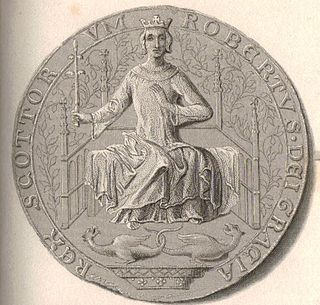
Robert II was King of Scots from 1371 to his death in 1390. The son of Walter Stewart, 6th High Steward of Scotland, and Marjorie, daughter of King Robert the Bruce, he was the first monarch of the House of Stewart. Upon the death of his uncle David II, Robert succeeded to the throne.
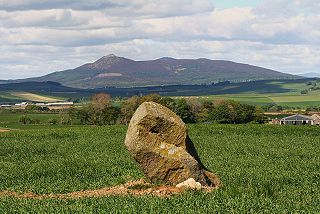
The Battle of Harlaw was a Scottish clan battle fought on 24 July 1411 just north of Inverurie in Aberdeenshire. It was one of a series of battles fought during the Middle Ages between the barons of northeast Scotland against those from the west coast.
The Earl or Mormaer of Ross was the ruler of the province of Ross in northern Scotland.
Hugh [probably Gaelic: Aodh], was the third successor of Ferchar mac in tSagairt as Mormaer of Ross (1323–1333).
WilliamIII, 5th Earl of Ross was a fourteenth-century Scottish nobleman. He was the fifth O’Beolan earl of Ross, descending from the founder of the line, Fearchar of Ross.
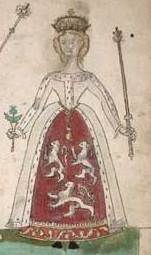
Euphemia de Ross (1329–1386), a member of Clan Ross, was Queen of Scots as the second wife of Robert II of Scotland.

Sir Walter Leslie was a 14th-century Scottish nobleman and crusader, one of the foremost knights of his time.
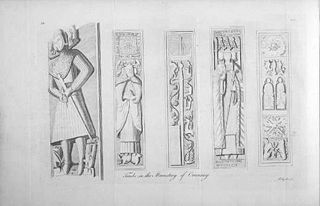
Donald, Lord of the Isles, was the son and successor of John of Islay, Lord of the Isles and chief of Clan Donald. The Lordship of the Isles was based in and around the Scottish west-coast island of Islay, but under Donald's father had come to include most of the isles and the lands of Somerled, the King of the Isles in the 12th century, Donald's predecessor, including Morvern, Garmoran, Lochaber, Kintyre and Knapdale on the mainland.

Alexander of Islay or Alexander MacDonald was a medieval Scottish nobleman who succeeded his father Domhnall of Islay as Lord of the Isles (1423–1449), later rising to the rank of Earl of Ross (1437–49). His lively career, especially before he attained the earldom of Ross, led Hugh MacDonald, the 17th century author of History of the MacDonalds, to commemorate him as "a man born to much trouble all his lifetime". Alexander allied himself with King James I of Scotland against the power of the Albany Stewarts in 1425 but, once the Albany Stewarts were out of the way, Alexander quickly found himself at odds with the new king. War with King James would initially prove Alexander's undoing, and would see the King's power in Scotland greatly increased, but at the Battle of Inverlochy Alexander's army prevailed against the forces of the King. Alexander died in 1449, having greatly extended his family's landed wealth and power. He was buried, not in the Isles of his ancestors, but at Fortrose Cathedral in his mainland Earldom of Ross.
Alexander Leslie, Earl of Ross was a Scottish nobleman. Born between 1367 and 1382, he was the son of Walter Leslie, Lord of Ross and Euphemia I, Countess of Ross. In around 1394, or not later than 1398, he became Earl of Ross and sometime before 1398 he married Isabel Stewart, daughter of Robert Stewart, Earl of Fife who became Robert Stewart, Duke of Albany. They had one child, Euphemia. He died at Dingwall, Scotland on 8 May 1402.
Euphemia II, Countess of Ross was the daughter of Alexander Leslie, Earl of Ross and his wife Isabella Stewart, daughter of Robert Stewart, 1st Duke of Albany. She was the only child and heir of Earl Alexander, and succeeded to the earldom de jure upon his death in 1402.
Mariota, Countess of Ross was the daughter of Euphemia I, Countess of Ross and her husband, the crusading war-hero Walter Leslie, Lord of Ross. Upon the death of her brother, Alexander Leslie, Earl of Ross, she became the heir-presumptive of her niece Euphemia II, Countess of Ross although her husband Domhnall of Islay, Lord of the Isles pressed Mariota's superior claim to the earldom.
Mairead inghean Eachainn, also known as Mairead nic Eachainn, was a consort of Alexander Stewart, Earl of Buchan. She was the daughter of a man named Eachann, and probably the mother of several children, including Alexander's like-named son, Alexander Stewart, Earl of Mar.

David Stewart, Prince of Scotland, was a 14th-century Scottish magnate. He was the eldest son of the second marriage of King Robert II with Euphemia de Ross. King Robert, on 26 March 1371, the day of his coronation, created him Earl of Strathearn, and on the following day his son David performed homage to his father as of Earl of Strathearn.
Euphemia Stewart, Countess of Strathearn was a medieval Scottish noblewoman, the daughter of David Stewart, Earl Palatine of Strathearn and Caithness. She succeeded to both her father's titles after his death between 1385 and 1389, probably March 1386.
Alexander Mackenzie, known as "Ionraic", traditionally counted as 6th of Kintail, was the first chief of the Clan Mackenzie of whom indisputable contemporary documentary evidence survives. During his long life, he greatly expanded his clan's territories and influence.
Colin Mackenzie of Kintail, nicknamed "Cam", was a Highland chief of the Scottish clan Mackenzie who greatly increased his ancestral estates through royal favour and a career of vigorous self-aggrandisement.
Kenneth Mackenzie, was the 10th laird of Kintail and he was nicknamed Coinneach na Cuirc in Scottish Gaelic, was a Highland chief, head of the Clan Mackenzie, who flourished in the turbulent Scottish politics of the mid-16th century.
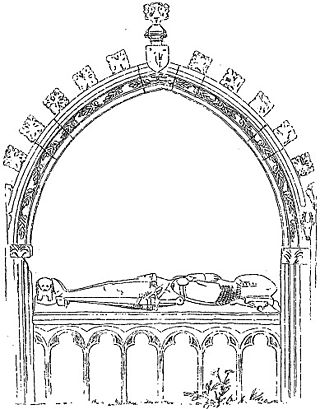
Kenneth Mackenzie, traditionally reckoned 7th of Kintail and nicknamed Coinneach a'bhlair, was a Highland chief, being head of the Clan Mackenzie.

Sir Alexander Lindsay of Glenesk was a Scottish knight banneret. Active in jousting and as a crusader he was in favour with the Scottish kings David II and Robert II.
References
- ↑ Paul, James Balfour (1910). The Scots Peerage. Edinburgh: David Douglas. Retrieved 28 January 2017.
- ↑ Leslie, Charles (1869). Historical records of the family of Leslie, from 1067 to 1868/9. Edinburgh: Edmonston and Douglas. p. 1:65–67, 175.
- ↑ Mackenzie, Alexander (1894). History of the Mackenzies. Inverness: A. & W. Mackenzie. p. 36 . Retrieved 28 January 2017.
euphemia ross walter leslie their heirs male and female in reversion.
- ↑ Paul. Scots Peerage. p. 240.
- ↑ Leslie. Historical Records. p. 67.
- ↑ Paul. The Scots Peerage. p. 241.
- ↑ Paul. Scots Peerage. p. 241.
- ↑ Mackenzie. History of the Mackenzies. p. 31.